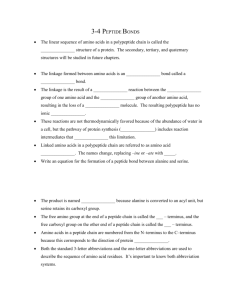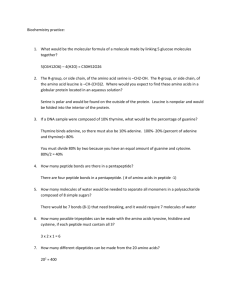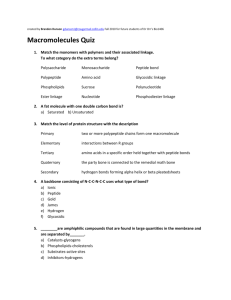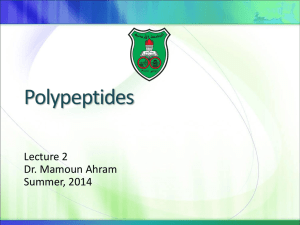OldExam1
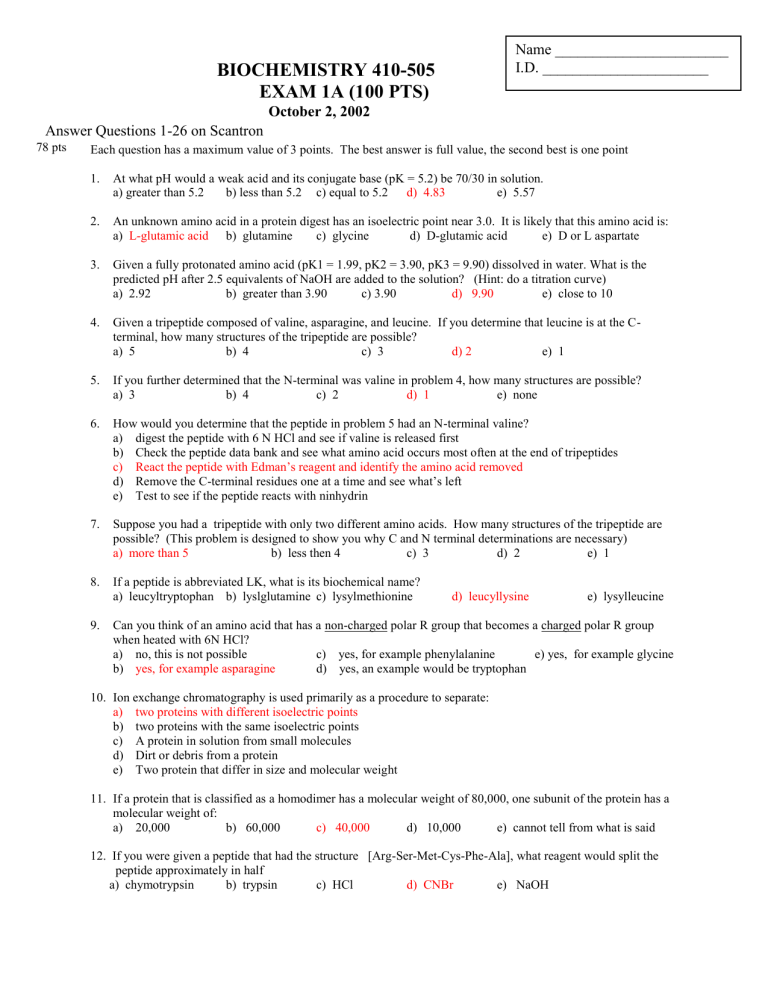
BIOCHEMISTRY 410-505
Name _______________________
I.D. ______________________
EXAM 1A (100 PTS)
Answer Questions 1-26 on Scantron
October 2, 2002
78 pts Each question has a maximum value of 3 points. The best answer is full value, the second best is one point
1.
At what pH would a weak acid and its conjugate base (pK = 5.2) be 70/30 in solution. a) greater than 5.2 b) less than 5.2 c) equal to 5.2 d) 4.83
e) 5.57
2.
An unknown amino acid in a protein digest has an isoelectric point near 3.0. It is likely that this amino acid is: a) L-glutamic acid b) glutamine c) glycine d) D-glutamic acid e) D or L aspartate
3.
Given a fully protonated amino acid (pK1 = 1.99, pK2 = 3.90, pK3 = 9.90) dissolved in water. What is the predicted pH after 2.5 equivalents of NaOH are added to the solution? (Hint: do a titration curve) a) 2.92 b) greater than 3.90 c) 3.90 d) 9.90
e) close to 10
4.
Given a tripeptide composed of valine, asparagine, and leucine. If you determine that leucine is at the Cterminal, how many structures of the tripeptide are possible? a) 5 b) 4 c) 3 d) 2 e) 1
5.
If you further determined that the N-terminal was valine in problem 4, how many structures are possible? a) 3 b) 4 c) 2 d) 1 e) none
6.
How would you determine that the peptide in problem 5 had an N-terminal valine? a) digest the peptide with 6 N HCl and see if valine is released first b) Check the peptide data bank and see what amino acid occurs most often at the end of tripeptides c) React the peptide with Edman’s reagent and identify the amino acid removed d) Remove the C-terminal residues one at a time and see what’s left e) Test to see if the peptide reacts with ninhydrin
7.
Suppose you had a tripeptide with only two different amino acids. How many structures of the tripeptide are possible? (This problem is designed to show you why C and N terminal determinations are necessary) a) more than 5 b) less then 4 c) 3 d) 2 e) 1
8.
If a peptide is abbreviated LK, what is its biochemical name? a) leucyltryptophan b) lyslglutamine c) lysylmethionine d) leucyllysine e) lysylleucine
9.
Can you think of an amino acid that has a non-charged polar R group that becomes a charged polar R group when heated with 6N HCl? a) no, this is not possible b) yes, for example asparagine c) yes, for example phenylalanine e) yes, for example glycine d) yes, an example would be tryptophan
10.
Ion exchange chromatography is used primarily as a procedure to separate: a) two proteins with different isoelectric points b) two proteins with the same isoelectric points c) A protein in solution from small molecules d) Dirt or debris from a protein e) Two protein that differ in size and molecular weight
11.
If a protein that is classified as a homodimer has a molecular weight of 80,000, one subunit of the protein has a molecular weight of: a) 20,000 b) 60,000 c) 40,000 d) 10,000 e) cannot tell from what is said
12. If you were given a peptide that had the structure [Arg-Ser-Met-Cys-Phe-Ala], what reagent would split the
peptide approximately in half
a) chymotrypsin b) trypsin c) HCl d) CNBr e) NaOH
+
H
3
N
COO
C
CH
A
2
H +
H
3
N
COO
C
CH
B
2
H +
H
3
N
COO
C
CH
2
C
H
CH
2
COO
SH
Questions 13-18 pertain to the structures above:
13 Which amino acid(s) above are drawn in an L-configuration a) A b) A and B c) B and C d) A and C e) ABC
14.
Which of the 3 when fully protonated would require 2 equivalents of base to titrate all protons a) A b) A and B c) B and C d) A and C e) ABC
15.
Which amino acid can form a disulfide bond with a neighboring amino acid a) A b) B c) C d) A or C e) A or B
16.
Which amino acid would most likely be found in the interior of a protein? a) A b) B c) C d) A or B e) all would
17.
Which amino acids would not absorb ultraviolet radiation? a) A b) B and C c) A and C d) ABC
18.
Which amino acid almost resembles the structure of serine? a) A b) B c) C d) A or C e) all would absorb e) B or C
19.
If the P50 of an oxygen-binding protein with one binding site is 15 torrs, at what oxygen pressure will this protein be 35% saturated with O
2
? a) 6.3 torrs b) 8.1 torrs c) 9.32 torrs d) 5.55 torrs e) 12.22 torrs
20.
Two proteins, A and B, both bind O
2
. A had twice the P50 value of B. When B is 50% saturated with O
2
, what is the percent saturation of A? a) 50% b) 25% c) 33% d) 15% e) 100%
21.
According to Pauling, an
helix in a protein is stabilized by _____________bonds a) electrostatic b) hydrophobic c) covalent d) disulfide e) hydrogen
22.
Predictions where strings of hydrophobic amino acids are found in a protein is achieved by knowing the: a) hydroscopic index c) the number of hydrophobic amino acids e) the pH of the solution b) hydropathic index d) the length of the peptide chain
23.
If you were told that a certain protein had an isoelectric point above 8, immediately you could predict that: a) the protein is very large and probably has a subunit structure b) the protein has a high complement of lysine or arginine residues c) the protein has a high complement of leucine, serine, and glycine d) the protein has a high complement of aspartic acid and glutamic acid e) there is very little that you can predict on the basis of that information
24.
If a protein sticks to a diethylaminoethyl (DEAE) cellulose column at pH 7.4, it is likely that this protein on a polyacrylamide gel in an electric field at pH 7.4 would: a) migrate towards the positive pole c) migrate towards either pole e) behave as a polycation b) migrate towards the negative pole d) break into subunits
6 pts
6 pts
10 pts pH
25.
The most dominant secondary structure of myoglobin is: a) heme residues c)
-helices b) peptide bonds d)
-sheets
26.
An acid solution makes hemoglobin bind O
because acid favors the _____conformer of hemoglobin a) weakly, T b) strongly, R c) weakly, R e) loops and turns pretty much at random d) strongly, T e) on the Fe, iron binding
SHORT ANSWERS
1. A peptide that was digested with trypsin and chymotrypsin gave the following smaller peptides. What is its structure of the parent peptide? (Hint: Look for overlaps. Peptide fragments are in random order)
Trypsin digestion: Tyr-Lys Phe-Arg Gly Met-Ile-Lys Phe-Ile-Lys
Chymotrysin digestion Ile-Lys-Phe Met-Ile-Lys-Tyr Arg-Gly Lys-Phe
Intact peptide (N
C):
_M I K Y K F I K F R G_____________
2.
Draw and name the structure of your favorite DIPEPTIDE. It may not contain any of the amino acids appearing on page 2 of this exam and it must have at least one amino acid with a dissociable proton in the R group.
3.
Draw the titration Curve of the peptide you drew and determine its isoelectric point. Points will be taken off for sloppiness and failure to put values on the X- and Y-axes.
Equivalents of NaOH
Do not write in this box




